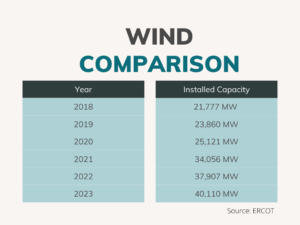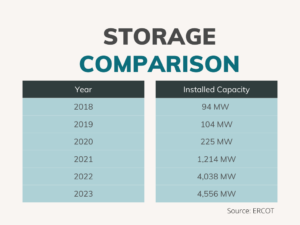Changes in the generation resource mix and related factors are contributing to new operational challenges for the grid operator.
________________________________________________
Solar power continues growing exponentially in Texas, although wind power and utility-scale battery storage also are making substantial gains, according to a recent ERCOT presentation.
The grid operator also reports that more than 6,000 megawatts of coal and natural gas generation have retired since 2018.
 Combined, these changes in the generation resource mix and related factors are contributing to new operational challenges for the grid operator, ERCOT reports. However, the organization also notes that $8 billion in transmission projects now underway should help it address these challenges.
Combined, these changes in the generation resource mix and related factors are contributing to new operational challenges for the grid operator, ERCOT reports. However, the organization also notes that $8 billion in transmission projects now underway should help it address these challenges.
Those findings and others were included in a December 23 presentation from ERCOT to the Texas Public Utility Commission relating to grid constraints. As part of its responsibilities, ERCOT — also known as the Electric Reliability Council of Texas — monitors areas of the network with such constraints, that is power bottlenecks that have the potential of overheating transmission lines and undermining grid stability. It addresses such challenges by redirecting power deployments on the grid in real-time, and by participating in a long-term transmission planning process.
“ERCOT continues to experience a rapid shift in the type and location of generation available to service demand,” the organization noted in its presentation to the PUC. “The change in generation mix has also resulted in increased distance between generation sites and demand centers. Retired coal and gas generation were closer to large cities, whereas the most abundant wind and solar resource stand to be in more distant locations.”
Relating to changes in the grid’s resource mix, ERCOT reported the following:
- Solar power increased by more than 500 percent between 2018 and 2021. From 2021 to 2023, it could nearly triple again. (In a separate report, ERCOT also reported that solar output has risen from a nearly inconsequential share of monthly
 generation — less than half a percent — to routinely more than 3.5 percent.)
generation — less than half a percent — to routinely more than 3.5 percent.) - Wind generation continues expanding in Texas, although — in percentage terms — not as dramatically as solar. From 2018 through 2023, wind generation on the grid will nearly double.
- Although still comprising a much smaller share of grid generation than wind and solar, the deployment of power storage — that is, battery-scale batteries — has increased exponentially.
A few other top line observations from the December presentation included:
- A rapidly changing resource mix and increasingly complex but flexible demand-side technology constitute important challenges and opportunities for ERCOT.
- Industrial demand growth remains strong on the ERCOT system, driven in part by oil and gas activity in West Texas and increased interest in data centers and cryptocurrency mining facilities.
- ERCOT may need new transmission technologies to help address system constraints. As such, ERCOT will continue evaluating the potential benefits of low-impedance alternating current (“AC”) transmission, higher voltage levels (e.g., 500 kV), high‑voltage direct current (“HVDC”) lines, advanced dynamic reactive power devices with grid-forming capabilities, and other technologies.
The report and included observations pertaining to several geographical areas of concern—including South Texas, West Texas and San Antonio. Among them:
- The Lower Rio Grande Valley possesses only limited conventional generation capacity. Nor does it have any conventional generation capacity planned. In addition, ERCOT forecasts the connection of more than seven gigawatts of intermittent renewable generation in the area. For these reasons, ERCOT sees sufficient transmission capacity as imperative to support the area. Policymakers have authorized two major transmission improvement projects in 2021 to meet reliability needs for the Lower Rio Grande Valley, and ERCOT expects implementation by 2027.
- West Texas Demand growth related to oil and gas activity in Far West Texas continues to outpace growth in the rest of the ERCOT system. To account for this rapid growth, ERCOT has incorporated a more granular and detailed load forecast for the region. Interest in developing data centers and new cryptocurrency mining facilities also is increasing rapidly in the region, while renewable generation connected to West Texas could exceed 38 gigawatts by 2023. These factors combined pose challenges for transmission planning.
- ERCOT foresees the need for significant transmission improvements in the San Antonio area to address the combination of future generation retirements and continued robust load growth. An ERCOT study identified reliability needs on the 138 kilovolt system northeast of San Antonio, as well as on the north and west sides of San Antonio’s 345-kV loop.
The ERCOT presentation on System Constraints can be found at this link.



